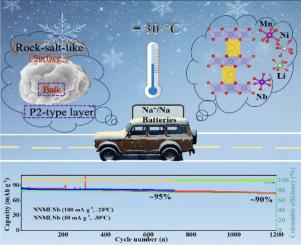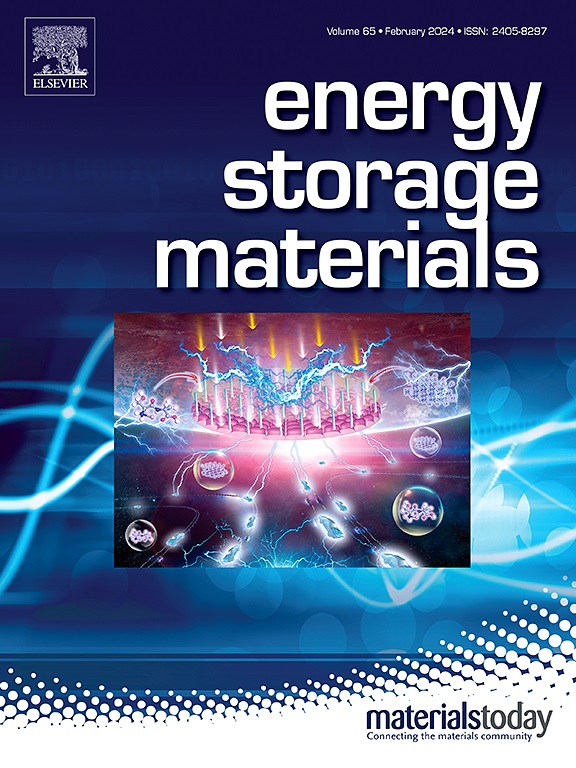用于低温超长寿命钠离子电池的锂铌双介导 P2 层阴极
IF 18.9
1区 材料科学
Q1 CHEMISTRY, PHYSICAL
引用次数: 0
摘要
本文章由计算机程序翻译,如有差异,请以英文原文为准。


Lithium and niobium dual-mediated P2-layered cathode for low-temperature and ultralong lifespan sodium-ion batteries
P2-type manganese-based cathode materials are notable for their high theoretical capacity and open prismatic channels. However, rapid capacity decay caused by harmful irreversible phase transformations (P2-O2) and oxygen release in the high-voltage region (>4.2 V) limits their commercial application. Here, a co-doping strategy with lithium and niobium is proposed to enhance the structural stability at both room-temperature (RT) and low-temperature (LT) over extended cycles. The X-ray absorption near-edge spectra and first-principles calculations reveal that Li doping elevates the valence states of transition metals, thereby enhancing the reversibility of anionic redox reactions. Additionally, Nb doping leads to the formation of a rock-salt-like phase on the surface, which improves the stability of the electrode/electrolyte interface. In situ X-ray diffraction and differential electrochemical mass spectrometry show that Li and Nb co-doping prevents the P2-O2 phase transition, suppresses gas release, and enhances long-cycle stability. The P2-Na0.67Ni0.24Mn0.64Li0.1Nb0.02O2(NNMLNb) exhibits a reversible specific capacity of 127.4 mAh g−1 and 101.5 mAh g−1 at -20 °C and -30 °C, respectively. Remarkably, the sample cycles stably for 1200 cycles with a discharge capacity of 85 mAh g−1, corresponding 90 % capacity retention. This work provides a novel strategy to improve the cycling life of sodium-ion batteries at both RT and LT.
求助全文
通过发布文献求助,成功后即可免费获取论文全文。
去求助
来源期刊

Energy Storage Materials
Materials Science-General Materials Science
CiteScore
33.00
自引率
5.90%
发文量
652
审稿时长
27 days
期刊介绍:
Energy Storage Materials is a global interdisciplinary journal dedicated to sharing scientific and technological advancements in materials and devices for advanced energy storage and related energy conversion, such as in metal-O2 batteries. The journal features comprehensive research articles, including full papers and short communications, as well as authoritative feature articles and reviews by leading experts in the field.
Energy Storage Materials covers a wide range of topics, including the synthesis, fabrication, structure, properties, performance, and technological applications of energy storage materials. Additionally, the journal explores strategies, policies, and developments in the field of energy storage materials and devices for sustainable energy.
Published papers are selected based on their scientific and technological significance, their ability to provide valuable new knowledge, and their relevance to the international research community.
 求助内容:
求助内容: 应助结果提醒方式:
应助结果提醒方式:


